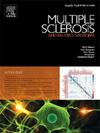老年多发性硬化症患者的肌肉减少症:一项横断面研究。
IF 2.9
3区 医学
Q2 CLINICAL NEUROLOGY
引用次数: 0
摘要
背景:老年多发性硬化症(pwMS)患者占MS患者总数的三分之一以上。衰老增加了肌肉减少症的风险,其特征是肌肉质量、力量和功能减少。目的:本研究的主要目的是调查使用欧洲老年人肌肉减少症工作组2 (EWGSOP2)诊断工具对老年pwMS的肌肉减少症的诊断如何受到基于上肢或下肢的测试的影响。方法:本横断面研究分析了PoTOMS试验的基线数据。共纳入n = 41例老年pwMS和n = 27例健康对照(HC)。使用EWGSOP2诊断工具和下肢肌力测试评估参与者的肌肉减少症。结果:与HC相比,老年pwMS的下肢肌肉质量和力量更低。根据EWGSOP2标准,5%的老年pwMS上肢力量下降,7%下肢力量下降,15%肌肉量减少。然而,尽管有这些减少,只有5%的人被诊断为肌肉减少症。结论:本研究表明,使用下肢测试对老年pwMS的肌肉减少症诊断更为敏感,与HC相比,老年pwMS的肌肉质量和力量更低。因此,当评估老年pwMS患者的肌肉减少症时,诊断测试应依赖于下肢测试。本文章由计算机程序翻译,如有差异,请以英文原文为准。
Sarcopenia in older people with multiple sclerosis: A cross-sectional study
Background
Older people with multiple sclerosis (pwMS) make up over one-third of the MS population. Ageing increases the risk of sarcopenia, characterised by reduced muscle mass, strength, and function. MS symptoms likely exacerbate sarcopenia, but its impact on older pwMS remains largely unexplored
Objectives
The primary aim of this study was to investigate how the diagnosis of sarcopenia using the European Working Group on Sarcopenia in Older People 2 (EWGSOP2) diagnostic tool in older pwMS is influenced by using upper extremity-based or lower extremity-based tests.
Methods
The present cross-sectional study analysed baseline data from the PoTOMS trial. A total of n = 41 older pwMS and n = 27 healthy controls (HC) were included. Participants were assessed for sarcopenia using the EWGSOP2 diagnostic tools and a lower extremity muscle strength test.
Results
Older pwMS had a preferentially lower muscle mass and strength in the lower extremities compared to HC. According to EWGSOP2 criteria, 5 % of older pwMS had reduced upper extremity strength, 7 % had reduced lower extremity strength, and 15 % had sarcopenic muscle mass. However, only 5 % were diagnosed with sarcopenia despite these reductions.
Conclusion
The present study shows that the sarcopenia diagnosis in older pwMS is more sensitive when using a lower extremity test, underlined by the preferentially lower muscle mass and strength in older pwMS compared to HC. Hence, when evaluating sarcopenia in older pwMS the diagnostics test should rely on the lower extremity test.
求助全文
通过发布文献求助,成功后即可免费获取论文全文。
去求助
来源期刊

Multiple sclerosis and related disorders
CLINICAL NEUROLOGY-
CiteScore
5.80
自引率
20.00%
发文量
814
审稿时长
66 days
期刊介绍:
Multiple Sclerosis is an area of ever expanding research and escalating publications. Multiple Sclerosis and Related Disorders is a wide ranging international journal supported by key researchers from all neuroscience domains that focus on MS and associated disease of the central nervous system. The primary aim of this new journal is the rapid publication of high quality original research in the field. Important secondary aims will be timely updates and editorials on important scientific and clinical care advances, controversies in the field, and invited opinion articles from current thought leaders on topical issues. One section of the journal will focus on teaching, written to enhance the practice of community and academic neurologists involved in the care of MS patients. Summaries of key articles written for a lay audience will be provided as an on-line resource.
A team of four chief editors is supported by leading section editors who will commission and appraise original and review articles concerning: clinical neurology, neuroimaging, neuropathology, neuroepidemiology, therapeutics, genetics / transcriptomics, experimental models, neuroimmunology, biomarkers, neuropsychology, neurorehabilitation, measurement scales, teaching, neuroethics and lay communication.
 求助内容:
求助内容: 应助结果提醒方式:
应助结果提醒方式:


